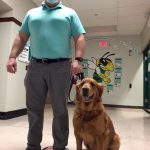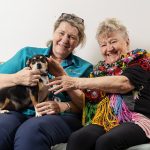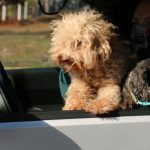Helping Guide Dog Teams
June 17, 2020

In this time when so many of our social rituals have changed to accommodate the new rules of a global pandemic, one thing remains a constant: the need to remember to always use your powers of observation and offer a comfortable “physical distance” around a guide dog and his human handler when they are out in a public setting. Guide dogs are the eyes of their handler–they are trained to lead the way safely and securely. But we can’t expect guide dogs to understand the current physical distancing practice of maintaining 6-foot clearances.
Guide dogs are trained to be decision makers. Even under stressful situations the intent of the dogs’ presence is to protect their handlers from harmful situations involving clearances around obstacles and navigating over dangerous under footings. When another party is in too close proximity, it can distract the dog from its tasks. Just as we humans like our space, guide dogs need space as well to perform their duties. Our wonderful guide dogs are specifically trained to make safe choices in public settings. This includes on stairways, elevators, and escalators; in supermarket aisles; around restaurant tables and along sidewalks. The long-standing message of being a careful observer applies when you are in the same vicinity as the guide dog team—especially when locating, entering, or exiting doorways. Remember that the dog knows to lead his handler with safe clearance, but he does not know how to create a 6-foot gap. I believe the guide dog’s presence should tell the story and that we humans must observe and react with care. The responsibility for recommended physical spacing in the presence of a working team should fall to the sighted party. Please decide when it is necessary to make the adjustment for 6-feet of distance between you, and do it in a casual manner. When you see a guide dog team approaching, be observant and add a small amount of space between you as needed. There is no reason for exaggeration, but it’s easy to add a little physical separation to comply with safety practices. A slight movement one way or another will help a lot. We each do it every day in our people-to-people encounters.
And please do this with subtlety and tact. The blind person approaching you does not want to feel awkward or to be put on the spot. Nor do they want to be given preferential treatment. Blindness in and of itself can be the cause of social isolation and often results in loneliness and distancing from life and human interaction. We are in no way suggesting that you avoid engaging with a visually impaired person–just not when that can interfere with their safety and health.
We are all having to make adjustments to adhere to the new protocols and safety measures designed to flatten the curve of Covid-19 in our daily lives. Thank you for being sensitive about giving our life-changing guide dogs a little more space in theirs.


 When Luke Hengen’s diabetes worsened in his early twenties, it stripped him of the outdoor activities where the country kid felt at home. Countless wilderness adventures and years of hard-fought football games took a toll on his body, to the point where he could no longer sense when his blood sugar was too high or […]
When Luke Hengen’s diabetes worsened in his early twenties, it stripped him of the outdoor activities where the country kid felt at home. Countless wilderness adventures and years of hard-fought football games took a toll on his body, to the point where he could no longer sense when his blood sugar was too high or […] When middle school students return to class on Jan. 11, they’ll find a new face at the door: Daisy. Daisy is a therapy dog and the personal pet of Rob Kreger, principal of the Rock L. Butler Middle School. The five-year-old golden retriever is not a school pet or mascot, but rather a working dog […]
When middle school students return to class on Jan. 11, they’ll find a new face at the door: Daisy. Daisy is a therapy dog and the personal pet of Rob Kreger, principal of the Rock L. Butler Middle School. The five-year-old golden retriever is not a school pet or mascot, but rather a working dog […] Last March, Caroline Benzel, a third-year medical student, began to notice the stress and discomfort her nurse friends were feeling from the pressures of the ongoing Covid-19 pandemic. “[Personal protective equipment] can be really rough on the skin,” Benzel, 31, tells PEOPLE. Benzel and her 3-year-old Rottweiler, Loki (who’s also a therapy dog) hatched a […]
Last March, Caroline Benzel, a third-year medical student, began to notice the stress and discomfort her nurse friends were feeling from the pressures of the ongoing Covid-19 pandemic. “[Personal protective equipment] can be really rough on the skin,” Benzel, 31, tells PEOPLE. Benzel and her 3-year-old Rottweiler, Loki (who’s also a therapy dog) hatched a […] When Stanley the miniature fox terrier’s owner passed away, the little dog started a ‘paw-some’ new role – bringing puppy love to some of the Gold Coast’s oldest residents. After Carinity Cedarbrook Diversional Therapist Julianne Staff adopted Stanley, he began visiting the aged care community at Mudgeeraba as a therapy dog. Therapy dogs help to […]
When Stanley the miniature fox terrier’s owner passed away, the little dog started a ‘paw-some’ new role – bringing puppy love to some of the Gold Coast’s oldest residents. After Carinity Cedarbrook Diversional Therapist Julianne Staff adopted Stanley, he began visiting the aged care community at Mudgeeraba as a therapy dog. Therapy dogs help to […] A nonprofit is providing an unusual form of therapy for those on the front lines of the coronavirus pandemic – puppy cams! “You spend five minutes with a puppy and try not to smile,” said registered nurse Robin Lingg Lagrone. Lingg Lagrone says watching little furballs wag their tails and prance on their paws helps […]
A nonprofit is providing an unusual form of therapy for those on the front lines of the coronavirus pandemic – puppy cams! “You spend five minutes with a puppy and try not to smile,” said registered nurse Robin Lingg Lagrone. Lingg Lagrone says watching little furballs wag their tails and prance on their paws helps […] When Moore County’s school doors were abruptly closed earlier in 2020, two- and four-legged volunteers from the Moore County Citizens’ Pet Responsibility Committee (PRC) were in their 12th year of presenting a six-session Pet Responsibility Education Program for fourth-graders. The PRC quickly shifted gears and placed its program materials online as part of a home […]
When Moore County’s school doors were abruptly closed earlier in 2020, two- and four-legged volunteers from the Moore County Citizens’ Pet Responsibility Committee (PRC) were in their 12th year of presenting a six-session Pet Responsibility Education Program for fourth-graders. The PRC quickly shifted gears and placed its program materials online as part of a home […]